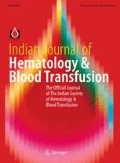Abstract
Transplant associated microangiopathy (TA-TMA) is a potentially serious complication of stem cell transplantation. Though stopping calcineurin/mTOR inhibitor is the first step in managing TA-TMA, this is not always adequate. The pathophysiology of TA-TMA is different from microangiopathy seen in other settings. Many drugs have been used in TA-TMA with modest responses. Defibrotide has been explored in TA-TMA in the past with good results. However, its availability is erratic and cost of therapy very high. Hence its routine use in low middle income country (LMIC) is financially demanding. We report the use of low dose defibrotide safely and successfully in this case series. This is pertinent more to LMIC’s and warrants prospective evaluation.
References
Fontana S, Kremer Hovinga JA, Lämmle B, Mansouri Taleghani B (2006) Treatment of thrombotic thrombocytopenic purpura. Vox Sang 90(4):245–254
Jodele S, Laskin BL, Dandoy CE, Myers KC, El-Bietar J, Davies SM et al (2014) A new paradigm: diagnosis and management of HSCT-associated thrombotic microangiopathy as multi-system endothelial injury. Blood Rev 29(3):191–204
Laskin BL, Goebel J, Davies SM, Jodele S (2011) Small vessels, big trouble in the kidneys and beyond: hematopoietic stem cell transplantation—associated thrombotic microangiopathy. Blood 118(6):1452–1462
Choi CM, Schmaier AH, Snell MR, Lazarus HM (2009) Thrombotic microangiopathy in haematopoietic stem cell transplantation: diagnosis and treatment. Drugs 69(2):183–198
Batts ED, Lazarus HM (2007) Diagnosis and treatment of transplantation-associated thrombotic microangiopathy: real progress or are we still waiting? Bone Marrow Transplant 40(8):709–719
Ruutu T, Barosi G, Benjamin RJ, Clark RE, George JN, Gratwohl A et al (2007) Diagnostic criteria for hematopoietic stem cell transplant-associated microangiopathy: results of a consensus process by an International Working Group. Haematologica 92(1):95–100
Uderzo C, Bonanomi S, Busca A, Renoldi M, Ferrari P, Iacobelli M et al (2006) Risk factors and severe outcome in thrombotic microangiopathy after allogeneic hematopoietic stem cell transplantation. Transplantation 82(5):638–644
George JN, Nester CM (2014) Syndromes of thrombotic microangiopathy. N Engl J Med 371(7):654–666
Cooke KR, Jannin A, Ho V (2008) The contribution of endothelial activation and injury to end-organ toxicity following allogeneic hematopoietic stem cell transplantation. Biol Blood Marrow Transplant 14((1 Suppl 1)):23–32
Gea-Banacloche JC (2010) Rituximab-associated infections. Semin Hematol 47(2):187–198
Kim SS, Patel M, Yum K, Keyzner A (2015) Hematopoietic stem cell transplant-associated thrombotic microangiopathy: review of pharmacologic treatment options. Transfusion 55(2):452–458
Hahn T, Alam AR, Lawrence D, Ford L, Baer MR, Bambach B et al (2004) Thrombotic microangiopathy after allogeneic blood and marrow transplantation is associated with dose-intensive myeloablative conditioning regimens, unrelated donor, and methylprednisolone T-cell depletion. Transplantation 78(10):1515–1522
Pescador R, Capuzzi L, Mantovani M, Fulgenzi A, Ferrero ME (2013) Defibrotide: properties and clinical use of an old/new drug. Vascul Pharmacol 59(1–2):1–10
Bagal B, Chandrasekharan A, Chougle A, Khattry N (2016) Low, fixed dose defibrotide in management of hepatic veno-occlusive disease post stem cell transplantation. Hematol Oncol Stem Cell Ther. https://doi.org/10.1016/j.hemonc.2017.02.005
Corti P, Uderzo C, Tagliabue A, Della Volpe A, Annaloro C, Tagliaferri E et al (2002) Defibrotide as a promising treatment for thrombotic thrombocytopenic purpura in patients undergoing bone marrow transplantation. Bone Marrow Transplant 29(6):542–543
Uderzo C, Fumagalli M, De Lorenzo P, Busca A, Vassallo E, Bonanomi S et al (2000) Impact of thrombotic thrombocytopenic purpura on leukemic children undergoing bone marrow transplantation. Bone Marrow Transplant 26(9):1005–1009
Richardson PG, Murakami C, Jin Z, Warren D, Momtaz P, Hoppensteadt D et al (2002) Multi-institutional use of defibrotide in 88 patients after stem cell transplantation with severe veno-occlusive disease and multisystem organ failure: response without significant toxicity in a high-risk population and factors predictive of outcome. Blood 100(13):4337–4343
Palmer KJ, Goa KL (1993) Defibrotide: a review of its pharmacodynamic and pharmacokinetic properties, and therapeutic use in vascular disorders. Drugs 45(2):259–294
Herper M (2010) The world’s most expensive drugs. Forbes. https://www.forbes.com/2010/02/19/expensive-drugs-cost-business-healthcare-rarediseases.html#4ef154795e10
Author information
Authors and Affiliations
Corresponding author
Ethics declarations
Conflict of interest
The authors declare no conflict of interest.
Ethical Approval
All procedures performed in studies involving human participants were in accordance with the ethical standards of the institutional and/or national research committee and with the 1964 Helsinki declaration and its later amendments or comparable ethical standards.
Informed Consent
Informed consent was obtained from all individual participants included in the study.
Rights and permissions
About this article
Cite this article
Devadas, S.K., Toshniwal, M., Bagal, B. et al. Successful Treatment of Transplant Associated Thrombotic Microangiopathy (TA-TMA) with Low Dose Defibrotide. Indian J Hematol Blood Transfus 34, 469–473 (2018). https://doi.org/10.1007/s12288-017-0904-y
Received:
Accepted:
Published:
Issue Date:
DOI: https://doi.org/10.1007/s12288-017-0904-y

